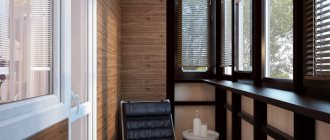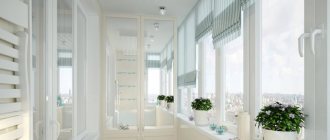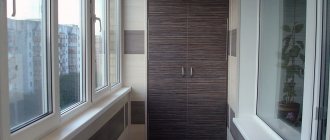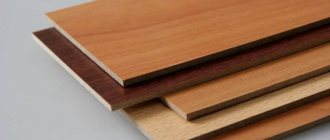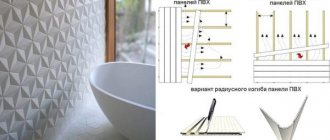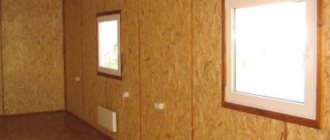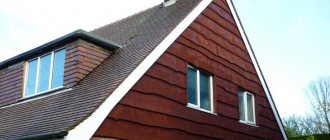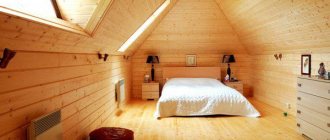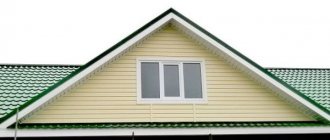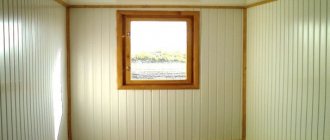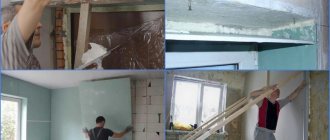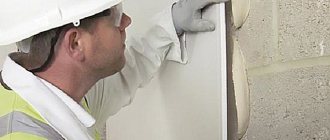The balcony is given one feature - it is a room that is usually not heated and has a high level of moisture when choosing a finishing material. Therefore, the finishing material for them must be moisture resistant and insensitive to different temperatures. For this reason, it is popular to use MDF panels for finishing balconies.
Finishing a balcony with MDF panels is distinguished by its simple technique, the production is fast and there is no mountain of dust and debris left after the work, unlike other types of work.
Using MDF you can hide uneven surfaces without additional leveling, which is very convenient and saves repair time.
The balcony in a modern house has ceased to play the role of a storage room for rubbish, but has priority as a relaxation area. Everyone ever wonders how to make this area cozy and beautiful.
Characteristics and types of MDF panels
MDF panels are a type of chips that are pressed together with reinforcing components. The process occurs under high temperature and pressure.
Wide selection of MDF panels.
MDF is a type of natural material in which there is nothing superfluous. Therefore, they can be used to cover both offices and apartments, including balconies.
- The panel is covered with a polymer film; it decorates and performs the function of protecting the material from moisture.
- On the outside there is a plate made of high-quality types of wood.
- A relief panel on which a design is cut out and varnished.
Return to content
No. 5. Wooden lining
Natural wood is not the most popular material for cladding balconies, which is due to its low resistance to numerous negative natural factors. This fact is the main disadvantage of wood, but modern technologies make it possible to use special impregnations in the production of wooden lining that protect the wood from moisture, rotting, pest damage and make it more resistant to fire. However, owners of balconies with such cladding will have to regularly care for the material so that it remains in its original form for as long as possible.
Among the main advantages of wooden lining:
- beautiful appearance that can enhance any balcony;
- environmental friendliness;
- heat and sound insulation properties.
Such cladding is unlikely to be appropriate when arranging a balcony in a typical apartment building, but for a small private house it is very suitable.
Pros and cons of the material
Advantages of finishing balconies with MDF panels:
- This type looks attractive;
- They have a special film, which makes them moisture resistant;
- The panels come in different colors, which makes it possible to get a unique balcony as a result;
- The panels have a long service life;
- It is very easy to clean and wash MDF;
- Has minimal costs;
- The panels can hide height differences, so there is no need to level the walls;
- Low thermal conductivity;
- From an environmental point of view, MDF, in comparison with chipboard, does not contain harmful substances;
- It’s easy to decorate a balcony with MDF panels yourself; you don’t need to spend money on a professional.
The disadvantages include:
- The panels are not resistant to contact with moisture.
- In case of increased moisture levels, covering the balcony with MDF panels will quickly become unusable.
- Condensate.
- Laminate flooring may swell if exposed to moisture.
- The panels are not shock resistant.
- The structure of MDF resembles cardboard in composition and appearance; as a result of an impact, a dent is formed.
Return to content
Glue mount
Applying glue to MDF panels Don't have time or opportunity to create lathing?
There is another way to attach finishing slabs - using glue, or rather liquid nails. The method is quite effective and easy. It’s done like this: Prepare the loggia by clearing the walls of wallpaper and plaster. A hammer can help in this matter - lightly tapping the walls will speed up the crumbling of the old coating. Treat the surface of the walls with a solution of cement-sand mixture
Pay special attention to areas with flaws. Wait a few days until the walls are completely dry. Cover the surface of the walls with wallpaper glue (primer). Use a roller. When it dries, start filling the walls. Place MDF boards according to the “from the corner” principle
Treat the slabs with construction glue, press them against the wall, remove excess glue with a knife. Continue working the same way.
Do-it-yourself balcony finishing with MDF panels
Balconies are an integral part of the apartment. It must have an attractive appearance. One of the interesting solutions that allows you to quickly and cheaply make repairs on the balcony is finishing the MDF balcony.
Video:
Return to content
What should you prepare for work?
MDF panels are very easy to install, so you can actually do all the work yourself, just buy the necessary tools and materials, and stick to simple work technology.
Initially, you need to take measurements of all the walls and ceiling (if it will be covered) and you need to calculate the square footage of the panels. The easiest way to find out the size of the balcony is to use a device like a folding meter. You can also use a laser rangefinder.
Separately, you need to count the number of external and internal corners to find out how many decorative strips you need to buy to finish the corners. This will help hide all the shortcomings of working on the corners, and you can also use them instead of ceiling friezes.
In order for balconies to be not only beautiful, but even more functional during the cold season, you need to insulate them using polystyrene foam, cotton wool and others.
Insulation is not necessary, but it is very important because... it maintains a more comfortable atmosphere on the balcony itself, saves heat in the apartment and prevents the destruction of panels from moisture and temperature changes. The amount of material that retains heat should be equal to the total area of the panels.
Do-it-yourself MDF installation is done on the lathing.
The materials and width of the frame depend on the presence of a layer that retains heat:
- In the case of sheathing, which is not designed without insulation, thin wooden slats are used for sheathing.
- In another situation, the frame is made of a metal profile or bars, the thickness of which must be equal to the thickness of the insulation.
Return to content
Choosing a frame for sheathing
The service life of the entire structure will depend on the choice of frame. An important point is humidity. It is ideal when moisture does not exceed 12 to 16% , but a maximum of 18% is allowed. The evenness of the surface depends on this.
Lathing that is attached to the wall using dowels. You can also attach it to wooden walls with self-tapping screws. To do this you will need a building level and a pencil.
The panels can also be placed vertically - this will visually increase the height of the balcony, or horizontally - it will expand the area.
As one of the options, a combined finish is used. In any situation, the bars must be placed perpendicular to the direction.
Return to content
Frame installation
Preparation for work on the installation of the frame is the application of markings.
This is an important stage on which the durability of the frame and the aesthetic perception of the structure depend after installing MDF on the balcony.
Incorrect calculations, inaccuracy and errors in the marking process can lead to distortion of the structure and excessive consumption of material.
Return to content
Fastening MDF panels
The panels can be attached from any angle. You need to remove the ridge from the first panel using a hand saw; the day before you need to mark the parts along the entire length. Before installing MDF panels on the wall, you need to clearly calculate what gaps remain after installing the penultimate panel - if the gaps are very narrow, it is better to cut a wide strip from the first panel to make the finish look aesthetically pleasing.
The first panel needs to be pressed with the cut side onto the sheathing of the adjacent wall and, using a self-tapping screw, attached to the frame slats, which are placed horizontally with an indentation of 1 cm from the edge.
Each subsequent panel is placed with a ridge into the MDF groove that was placed before it and secured with clamps. The last element is cut to width, and its edge is fastened with self-tapping screws to the vertical batten of the sheathing.
Return to content
The final stage of work
After the balcony is covered with MDF, you need to glue the ceiling and floor plinth. Then all internal and external corners need to be covered with special decorative elements - split corners for MDF, matched to the tone of the finish.
We place the split corners on glue, which is convenient to apply in a thin snake along the entire length of the element.
A beginner can do a good job of covering balcony walls with MDF panels on his own. If you choose a renovation with lathing, it is important to accurately calculate the amount of materials and fasteners needed. We advise you to draw a detailed diagram in advance and take all measurements.
Return to content
We decide what is better to cover the inside of the balcony based on reviews from professionals
As for the other criteria, drywall not only meets, but also comes to the fore against the background of the rest of the cladding. In terms of durability, the canvas can last for decades, provided that the maintenance conditions are met. In other words, if water constantly gets on the canvas, and the product is not moisture-resistant, then it will soon deteriorate.
The material can be painted, pasted over and even textured plaster applied to it. Accordingly, it can be safely called practical. A room decorated with plasterboard sheets looks neat and has straight corners and straight walls. Installing the canvas does not require a lot of effort and time. It is enough to install a metal sheathing made of profiles. In some cases, sheathing for plasterboard walls is made of wood.
As for maintainability, the only drawback of the canvas is fragility. When installed, it is very easy to break, and therefore you should be as careful as possible, because it cannot be restored.
The most economical option is whitewashing
Light whitewash in pastel colors
Whitewashing is one of the traditional methods of decorating walls on a balcony. In addition to the obvious financial benefits, it has many other advantages:
- Simplicity and speed of execution
- Availability of coating in any building materials store
- Lime dries quickly and does not emit unpleasant odors.
- For variety, you can add colors to the composition so that the walls become colored
- Any person without special repair skills can whitewash surfaces.
In order for the walls to look neat and elegant, they must first be prepared. The leveled surfaces are covered with a primer and wait until it dries. Whitewash is applied in two or three layers.
Among the shortcomings is that the coating looks boring and old-fashioned, without any zest. The limestone layer also accepts dust well, so the whitewash will have to be renewed every 6-8 months.
